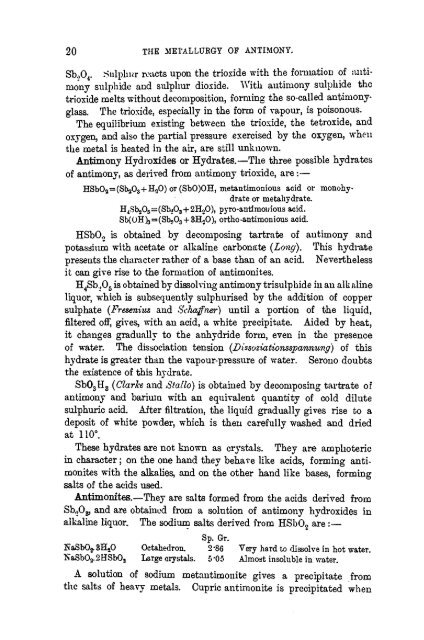antimony - Sciencemadness.org
antimony - Sciencemadness.org
antimony - Sciencemadness.org
Create successful ePaper yourself
Turn your PDF publications into a flip-book with our unique Google optimized e-Paper software.
20 THE METALLURGY OF ANTIMONY.<br />
Sb04. Sulphur reacts upon the trioxide with the formation of <strong>antimony</strong><br />
sulphide and sulphur dioxide. With <strong>antimony</strong> sulphide the<br />
trioxide melts without decomposition, forming the so-called <strong>antimony</strong>glass.<br />
The trioxide, especially in the form of vapour, is poisonous.<br />
The equilibrium existing between the trioxide, the tetroxide, and<br />
oxygen, and also the partial pressure exercised by the oxygen, when<br />
the metal is heated in the air, are still unknown.<br />
Antimony Hydroxides or Hydrates.—The three possible hydrates<br />
of <strong>antimony</strong>, as derived from <strong>antimony</strong> trioxide, are:—<br />
HSb03=(Sb203 + H20) or(SbO)OH, metantimonious acid or monohydrate<br />
or metahydrate.<br />
H4Sb2O5 = (Sbo03 + 2H2O), pyro-antiraonious acid.<br />
Sb{OH)3 = (Sb2O3 + 3H2O), ortho-anthnonious acid.<br />
HSbO2 is obtained by decomposing tartrate of <strong>antimony</strong> and<br />
potassium with acetate or alkaline carbonate (Long), This hydrate<br />
presents the character rather of a base than of an acid. Nevertheless<br />
it can give rise to the formation of antimonites.<br />
H4Sb.,O5 is obtained by dissolving <strong>antimony</strong> trisulphide in an alk aline<br />
liquor, which is subsequently sulphurised by the addition of copper<br />
sulphate (Fresenius and Schaffner) until a portion of the liquid,<br />
filtered off, gives, with an acid, a white precipitate. Aided by heat,<br />
it changes gradually to the anhydride form, even in the presence<br />
of water. The dissociation tension (Dissoziationsspannung) of this<br />
hydrate is greater than the vapour-pressure of water. Serono doubts<br />
the existence of this hydrate.<br />
SbO3Hs (Clarice and Stallo) is obtained by decomposing tartrate of<br />
<strong>antimony</strong> and barium with an equivalent quantity of cold dilute<br />
sulphuric acid. After nitration, the liquid gradually gives rise to a<br />
deposit of white powder, which is then carefully washed and dried<br />
at 110°.<br />
These hydrates are not known as crystals. They are amphoteric<br />
in character; on the one hand they behave like acids, forming antimonites<br />
with the alkalies, and on the other hand like bases, forming<br />
salts of the acids used.<br />
AntiTnonites.—They are salts formed from the acids derived from<br />
Sb.-jOg, and are obtained from a solution of <strong>antimony</strong> hydroxides in<br />
alkaline liquor. The sodium salts derived from HSbO2 are:—<br />
Sp. Gr.<br />
NaSbOo-SBy) Octahedron. 2*86 Very hard to dissolve in hot water.<br />
2saSbO2.2HSbO2 Large crystals. 5*05 Almost insoluble in water.<br />
A solution of sodium metantimonite gives a precipitate from<br />
the salts of heavy metals. Cupric antimonite is precipitated when
















